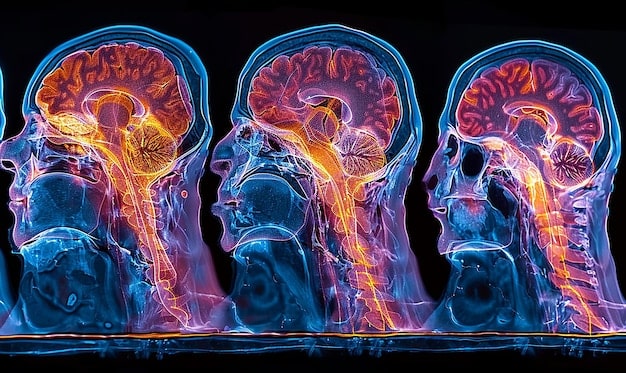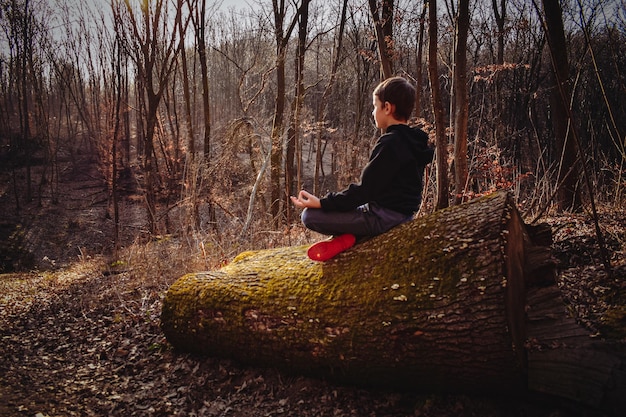The Science of Gratitude: A 21-Day Path to Mental Well-being

The Science of Gratitude: How a 21-Day Practice Can Improve Your Mental Well-being explores the scientifically proven benefits of gratitude and provides a practical guide to cultivating thankfulness through a 21-day practice, leading to enhanced mental well-being.
Embarking on a journey of self-improvement often leads us to explore practices that promise enhanced mental well-being. Among these, the power of gratitude stands out, backed by compelling scientific evidence. This article explores the science of gratitude: how a 21-day practice can improve your mental well-being, offering insights and a practical guide to cultivating thankfulness.
Understanding the Science of Gratitude
Gratitude, often perceived as a simple act of saying “thank you,” has profound psychological and physiological effects. Scientific research has revealed that expressing gratitude can significantly improve mental health, reduce stress, and foster a greater sense of happiness.
The Neurological Basis of Gratitude
Studies using neuroimaging techniques have shown that gratitude activates several brain regions associated with reward, positive emotion, and social connection. These include the ventral tegmental area (VTA), which plays a key role in dopamine production, and the prefrontal cortex, involved in decision-making and emotional regulation.
Gratitude and Stress Reduction
Chronic stress can wreak havoc on both mental and physical health. However, consistently practicing gratitude has been shown to lower cortisol levels, the body’s primary stress hormone. By reducing stress, gratitude contributes to improved mood, sleep quality, and overall well-being.

Research has consistently proven that gratitude has amazing health benefits. But how can we feel it and make it part of our lives? Let’s see some ways.
- Gratitude journaling: Regularly writing down things you are thankful for.
- Expressing gratitude to others: Verbally acknowledging and appreciating the actions of those around you.
- Gratitude meditations: Focusing on feelings of thankfulness during meditation practices.
The scientific foundation of gratitude is rooted in its capacity to reshape brain activity and reduce stress. By engaging in regular practices of gratitude, individuals can harness these benefits to improve their overall mental and emotional well-being.
Benefits of a 21-Day Gratitude Practice
Committing to a 21-day gratitude practice can unlock a multitude of benefits, fostering a more positive outlook on life and enhancing overall mental wellness. This structured approach provides a framework for consistently cultivating gratitude, leading to lasting improvements in mood and emotional resilience.
Improved Mood and Well-being
One of the most immediate benefits of practicing gratitude is a noticeable improvement in mood. By focusing on the positive aspects of life, individuals can shift their attention away from negative emotions and cultivate a more optimistic mindset. This, in turn, leads to a greater sense of overall well-being.
Enhanced Relationships
Expressing gratitude towards others strengthens relationships and fosters deeper connections. When we acknowledge and appreciate the actions of those around us, we create a positive feedback loop that encourages kindness and reciprocity. This can lead to more fulfilling and supportive relationships.
- Increased empathy: Developing a greater understanding and compassion for others.
- Improved communication: Fostering more open and honest interactions.
- Stronger social support: Building a network of supportive relationships.
Studies have proven that gratitude has many benefits, including the improvement of sleep quality. When we are grateful, we have an overall better mood. But a more restful night is always great.
The benefits of a 21-day gratitude practice extend far beyond simple expressions of thankfulness. This structured approach can lead to lasting improvements in mood, relationships, and overall mental well-being.
Designing Your 21-Day Gratitude Challenge
Embarking on a 21-day gratitude challenge requires careful planning and a commitment to consistent practice. Designing the challenge to align with your personal preferences and lifestyle will increase the likelihood of success and maximize the benefits.
Setting Realistic Goals
Before starting the challenge, it’s important to set realistic goals that are achievable and sustainable. Avoid overwhelming yourself with ambitious targets, and instead focus on small, incremental steps that can be easily integrated into your daily routine.
Choosing Gratitude Practices
There are several gratitude practices to choose from, each offering unique benefits. Experiment with different techniques to find the ones that resonate most with you and that you can consistently incorporate into your daily life. You can alternate through the days as well.
In short bursts, here are some ways we can design your 21-day challenge:
- Gratitude journaling prompts: Using specific prompts to guide your journaling efforts.
- Gratitude jar: Writing down things you are thankful for and placing them in a jar to be read later.
- Gratitude walks: Taking time to appreciate the beauty and wonder of nature.
The design phase of a 21-day gratitude challenge is crucial for setting the stage for success. By setting realistic goals, choosing meaningful practices, and integrating the challenge into your daily routine, you can create a transformative experience that fosters lasting gratitude.
Overcoming Challenges During the 21-Day Practice
Even with careful planning, challenges can arise during a 21-day gratitude practice. It’s important to anticipate potential obstacles and develop strategies for overcoming them, ensuring that you stay committed to the challenge and reap the rewards.
Dealing with Negative Emotions
It’s natural to experience negative emotions from time to time, even while practicing gratitude. Instead of suppressing these feelings, acknowledge them and allow yourself to feel them fully. Then, gently redirect your attention back to the positive aspects of your life.
Maintaining Consistency
Consistency is key to the success of any gratitude practice. When faced with busy schedules or competing priorities, it can be tempting to skip a day or two. However, even small acts of gratitude can make a big difference. Try to find ways to integrate gratitude into your daily routine, such as practicing gratitude during your commute or before going to bed.

Some ways we can overcome any hardships while doing it:
- Accountability partners: Enlisting the support of a friend or family member to help you stay on track.
- Reminders and prompts: Setting reminders on your phone or computer to practice gratitude throughout the day.
- Flexibility: Adjusting your gratitude practices to fit your current circumstances and energy levels.
Life can have struggles, but we can always come up on top.
Overcoming challenges is an integral part of any gratitude practice. By anticipating potential obstacles and developing strategies for dealing with them, you can stay committed to the challenge and reap the transformative benefits of gratitude over the course of 21 days.
Tracking Progress and Measuring Results
As you progress through your 21-day gratitude challenge, it’s helpful to track your progress and measure the results. This will not only keep you motivated but also provide valuable insights into the impact of gratitude on your mental well-being.
Journaling and Self-Reflection
Regular journaling is a powerful tool for tracking your progress and reflecting on your experiences. Take time each day to write about your gratitude practices, noting any changes in your mood, relationships, or overall well-being. As time passes, you will notice positive changes.
Using Gratitude Scales and Questionnaires
Various gratitude scales and questionnaires are available online that can help you quantify your levels of gratitude. These tools can provide a more objective measure of your progress and help you identify areas where you may want to focus your efforts.
If you want even more results, you can consult a professional, they will surely have some useful tips.
Tracking your progress and measuring the results is one of the most important things in this journey, so you can check if you are having results or not.
Tracking progress and measuring results are essential components of a successful 21-day gratitude practice. By using journaling, gratitude scales, and other feedback mechanisms, you can gain a deeper understanding of the transformative power of gratitude and stay motivated to continue cultivating thankfulness in your life.
Sustaining Gratitude Beyond the 21-Day Challenge
While a 21-day gratitude challenge can be a powerful catalyst for change, the true benefits of gratitude are realized when it becomes a sustained practice integrated into your daily life. Continuing to cultivate gratitude beyond the initial challenge can lead to lasting improvements in mental well-being and overall happiness.
Making Gratitude a Habit
The key to sustaining gratitude is to turn it into a habit. Find ways to incorporate gratitude into your daily routine, such as practicing gratitude during your commute, before meals, or before going to bed. The more you practice gratitude, the more natural it will become.
Sharing Gratitude with Others
Sharing your gratitude with others is a powerful way to reinforce your own feelings of thankfulness and strengthen your relationships. Make a conscious effort to express your appreciation to the people in your life, whether it’s through a heartfelt thank-you note or a simple gesture of kindness.
Having a supportive community of people who understand your journey is a good idea as well, you wouldn’t fell alone:
- Online gratitude communities: Connecting with others who share your passion for gratitude.
- Gratitude challenges: Participating in ongoing challenges to stay motivated and inspired.
Sustaining gratitude beyond the 21-day challenge requires a long-term commitment and a willingness to integrate gratitude into your daily life. By making gratitude a habit, sharing it with others, and seeking ongoing support, you can reap the lasting benefits of thankfulness and cultivate a happier, more fulfilling life.
| Key Point | Brief Description |
|---|---|
| 🧠 Neurological Basis | Gratitude activates brain regions associated with reward and positive emotion. |
| 😌 Stress Reduction | Practicing gratitude lowers cortisol levels, reducing stress and improving mood. |
| 🤝 Enhanced Relationships | Expressing gratitude strengthens bonds and fosters deeper connections with others. |
| 🗓️ Sustained Habit | Making gratitude a daily habit leads to lasting improvements in well-being. |
Frequently Asked Questions
▼
Gratitude activates brain regions associated with reward, positive emotion, and social connection, such as the ventral tegmental area (VTA) and the prefrontal cortex. This activation leads to improved mood and reduced stress.
▼
A 21-day practice helps in shifting focus towards positive aspects, fostering optimism, improving relationships through expressing appreciation, and ultimately enhancing overall mental well-being.
▼
Effective practices include gratitude journaling (writing things you’re thankful for), gratitude jar (collecting thankful moments), and expressing gratitude verbally to others to strengthen relationships.
▼
Challenges include dealing with negative emotions, maintaining consistency, and managing busy schedules. Overcome them by acknowledging feelings, finding accountability partners, and integrating gratitude into daily routines.
▼
Sustain gratitude by turning it into a habit, sharing gratitude with others, joining online communities, or participating in ongoing gratitude challenges. Make it a natural part of daily life.
Conclusion
Embracing the science of gratitude: how a 21-day practice can improve your mental well-being is a powerful investment in your mental and emotional health. By understanding the scientific basis of gratitude, designing a personalized practice, and overcoming challenges along the way, you can unlock the transformative benefits of thankfulness and cultivate a happier, more fulfilling life.
“





